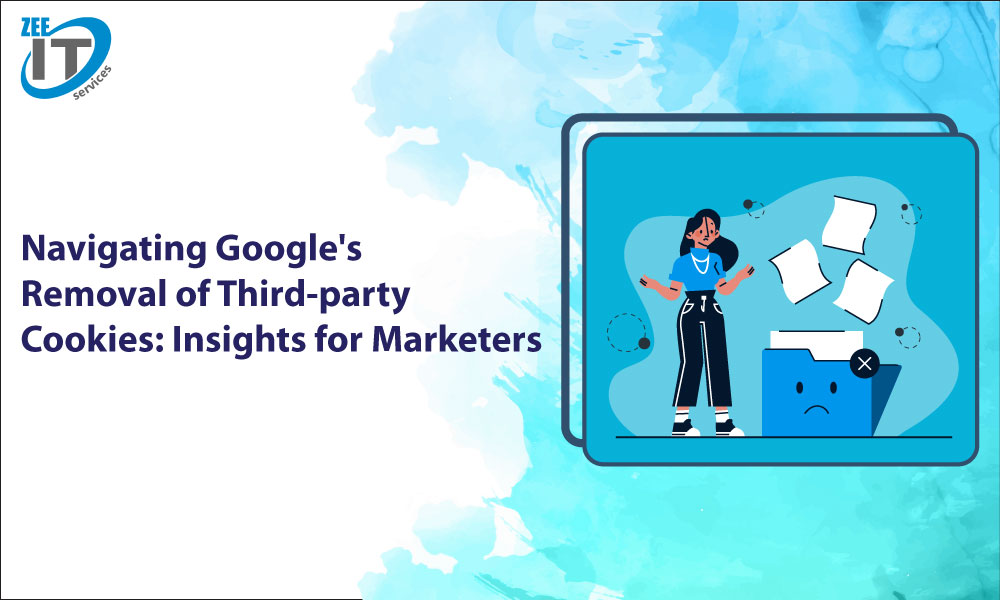Google’s move to gradually phase out third-party cookies has generated a lot of discussion and controversy in recent years. Google’s 2024 commitment to this strategy, which was first stated in 2023, created the foundation for a major change in internet advertising methods. Major web browsers, including Google Chrome and Mozilla Firefox, have announced this change. Although there is still a little change in the implementation schedule. Regulatory authority consultation is scheduled to initiate a progressive phaseout starting in the third quarter of 2024. The removal of third-party cookies will significantly impact most of the advertising field. Let’s explore in detail the significant effects of this change on advertising strategies and the whole digital environment.
What are cookies?
Before exploring Google’s intentions, it is important to understand the function of cookies in web browsing. Users typically see notifications to allow cookies when they visit websites. However, exactly what are cookies? In simple terms, browsers store small files known as cookies, which websites use to monitor user preferences and activity. Subsequently, this data is utilized to offer users customized browsing experiences tailored to their unique interests and browsing behaviors. Cookies enable the storage of user preferences, improvement of user experience, and monitoring of user activity, among other functionalities.
Types of cookies
There are two types of cookies included:
First-party cookies: These cookies are created by the website that the user is currently visiting. Their main purpose is to improve the website’s functionality and offer the customer a customized browsing experience. First-party cookies can store information such as login credentials, language preferences, and shopping cart items. They often see them as less intrusive and frequently consider them important for the smooth operation of websites in terms of user privacy.
Third-party cookies: These cookies are created by domains other than the website that the user is currently visiting. Third-party cookies are frequently linked to online ad networks and analytics businesses, and they are frequently used to track user behavior across various websites. They can collect information such as browsing history, interests, and demographic data to deliver targeted advertisements and analyze website performance. Third-party cookies have raised concerns regarding user privacy and data security, leading to increased monitoring and regulatory measures aimed at restricting their usage.
Why is Google taking action on third-party cookies?
Several important considerations influence Google’s decision to take action regarding third-party cookies.
First of all, in the age of technology, user privacy and data protection are becoming increasingly important. There is a growing need for more open and user-focused data practices as internet users become more conscious of the consequences of online tracking.
Second, higher standards for data privacy and permission have been implemented by government policies like the California Consumer Privacy Act (CCPA) and the General Data Protection Regulation (GDPR). Compliance with these requirements demands a reassessment of data gathering and tracking procedures, including the utilization of third-party cookies.
Moreover, companies like Google have had to prioritize privacy as a fundamental value and take proactive measures to address concerns about data security and privacy, prompted by the evolving regulatory landscape and heightened public attention.
Google’s Privacy Sandbox
Google announced the Privacy Sandbox, a ground-breaking program designed to protect user privacy while yet permitting efficient advertising methods, in the middle of the shift away from third-party cookies. By exchanging anonymized signals for cookies, this creative approach protects user privacy while giving marketers insightful data on user attribution and ad performance metrics. The Privacy Sandbox makes it easier for advertisers to make the switch to a cookie-less environment by encouraging them to use APIs for aggregated data and interface directly with Google’s advertising platforms.
Marketers are recommended to update their plans and use new measuring techniques in light of these developments to effectively move through the changing landscape. It becomes clear that enhancing first-party data strategies is essential if marketers are to use data gathered directly from user interactions to power customized advertising campaigns. Additionally, marketers can precisely assess the efficacy of their advertising campaigns by implementing innovative measuring techniques like causal proof studies.
In addition, as a result of the current advertising landscape, marketers are encouraged to investigate substitute marketing channels that do not rely as much on cookies. Without depending on traditional cookie-based monitoring methods, marketers have ways to successfully reach their target audience through opportunities like Digital Out Of Home (DOOH) and Connected TV. Without using third-party cookies, marketers can maintain and even increase the reach of their campaigns by utilizing creative strategies and a variety of marketing channels.
Alternative to Third-party Cookies:
Federated Learning of Cohorts (FLoC), one of the main alternatives for third-party cookie replacements, is being highly studied by Google. This cutting-edge technology works by using algorithms built into the Chrome browser to classify users into cohorts based on their interests and activities. Then, using in-market and affinity audience segments, advertisers can target these cohorts with more traditional targeting techniques.
It’s important to remember, though, that FLoC offers far different privacy protection than third-party cookies. By assembling people into cohorts, FLoC hides users and protects their privacy in contrast to cookies, which monitor specific user activity. This method addresses several important issues with cookies, including intrusive tracking and unauthorized data gathering.
As a first step toward putting this alternate approach into practice, Google has revealed intentions to begin rolling out FLoC testing with advertisers using Google Ads in April 2021. Furthermore, Google plans to implement trial controls for the Privacy Sandbox, giving users the choice to participate in or not.
Impacts of removal of third-party cookies on advertisers
There has been much discussion on the possible effects of third-party cookie removal on advertising. Although Google’s Federated Learning of Cohorts (FLoC) offers an appropriate replacement, its effectiveness is still up for question. If FLoC performs as well as Google says it will, with a 95% accuracy rate that is on track with cookies, the switch may go smoothly with not much detectable variation in advertising tactics. However, there might be several serious consequences if FLoC doesn’t live up to expectations:
Effect on Companies Relying on Third-Party Cookies:
Companies whose marketing strategies are significantly dependent on third-party cookies for targeted advertising can face difficulties. The inability to track users across websites could limit their ability to deliver personalized ads effectively.
Rethinking Advertising Strategies:
In the context of the cookie-less environment, advertisers will have to reconsider their advertising strategies. Maintaining advertising effectiveness will require exploring alternative techniques for audience targeting and ad customization.
Rise of First-Party Cookies:
First-party cookies are expected to play a bigger part in advertising as third-party cookies become less common. To provide tailored advertising, advertisers can rely more and more on information gleaned straight from user interactions on their own platforms.
Effect on Advertising Publishers:
Publishers who rely on third-party cookie data for ad targeting may find it harder to attract advertisers in the future. Publishers can gain a competitive advantage if they can emphasize user privacy or provide alternative targeting options.
Affiliate Marketing Requirements:
Affiliate marketers will need to adjust how they measure user interactions and conversions as a result of the removal of third-party cookies. Maintaining affiliate marketing efficacy will require using first-party data or different tracking strategies.
Benefits for Enterprise-Level Companies:
In the post-cookie era, companies with sizable consumer data repositories can find themselves at a competitive advantage over smaller companies. They could be more equipped to adjust to the shifting advertising market if they can make use of first-party data and powerful analytics technologies.
Impact of Third-party Cookies on Consumer Data Privacy
Removing third-party cookies is a big step forward in protecting the privacy of user data. Removing these cookies gives customers more control over their personal data, reducing unnecessary tracking and enhancing privacy protection. Particularly in terms of tailored advertising and focused marketing strategies, this change has broad consequences for the digital environment.
Removing third-party cookies has several benefits, one of which is reducing the presence of unwanted tracking systems that harm user privacy. Through the use of these cookies, monitoring firms and marketers are able to keep tabs on users’ online actions across several websites and compile comprehensive profiles of their interests, preferences, and habits. As a result, the frequent feeling among customers is that someone is watching their every action, raising concerns about data security and privacy.
In addition, the elimination of third-party cookies lessens the occurrence of customized and targeted advertisements, many of which rely on intensive user monitoring and profiling. To present content that is specific to each user’s interests and actions, these advertisements rely on information gathered by third-party cookies. However, in the absence of this monitoring system, marketers would have less access to detailed user data, which would make providing highly customized advertisements more difficult.
Frequently Asked Questions:
What is Google’s Removal of Third-party Cookies?
Google’s removal of third-party cookies refers to its decision to phase out support for these tracking mechanisms in its Chrome browser, impacting how advertisers track and target users across the web.
Why is Google Removing Third-party Cookies?
Google aims to enhance user privacy by eliminating third-party cookies, which are often used for targeted advertising. This move aligns with growing privacy concerns and regulatory changes.
How Will Marketers Be Affected by This Change?
Marketers will need to adapt their advertising strategies to rely less on third-party cookies for targeting and measurement. Alternative methods such as first-party data and contextual targeting will become essential.
What Strategies Can Marketers Implement to Navigate This Change?
Marketers can explore options like leveraging first-party data, embracing contextual targeting, and investing in privacy-centric advertising solutions. Diversifying advertising channels and focusing on user consent are also crucial.
What Should Marketers Do to Prepare for Google’s Removal of Third-party Cookies?
Marketers should assess their current reliance on third-party cookies and begin implementing alternative strategies. This may involve updating data collection practices, partnering with privacy-focused vendors, and staying informed about industry developments.

